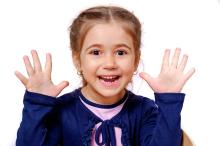
Body awareness is the knowledge of a person’s body parts along with the knowledge of what the parts can do and how to make the parts move. Body awareness is one of the components to develop perceptual-motor learning along with spatial awareness, directional awareness, and temporal awareness.1
Body awareness helps people orient their bodies to their surrounding environment and helps them navigate through that space. Proprioception plays a large part in relaying information received from the movement and the force of muscles and joints to allow for successful movement.2
Young infants first notice their hands in their discovery of their bodies. Once they can hold a rattle, their movements with it begin to develop their spatial understanding along with coordination of their vision, muscle control, and movement planning. The most effective way for children to gain body awareness is through active exploration.3
Body-part identification is a key element of body awareness. Simple games for young children to help them learn their body parts include playing “I’ve got your nose!” and “Show me” to engage children to recognize their various body parts. By age 7, most children know their large and small body parts.4
Young children gain a sense of their bodies as they complete tasks over and over again.5 They relate bodily experiences with spatial awareness. They develop their understanding of their relationship to their environment and begin to make judgments of what is their space compared to others’ space.6
Body awareness includes awareness of movements that the human body can perform. These include locomotor movements, such as walking, running, and jumping; stabilizing movements, such as bending, twisting, and turning; and manipulative movements, such as throwing, catching, and bouncing.7
Children with poor body awareness may appear awkward and clumsy. They may trip over their own feet, because they are less aware of where their body parts are in space. They may have difficulty imitating another’s movement, not understanding how to move their own bodies in the same way. They may prefer to be in confined spaces or under blankets as opposed to open spaces, because it makes them feel more secure to understand their familiar environment. Because they rely on their vision to determine where they are in space, children with decreased body awareness often do not like to be in the dark or to close their eyes. With their decreased processing of proprioceptive information, they may prefer to be held tightly while hugged to give them more input to their joints and muscles. Occupational therapy can improve children’s ability to process the feeling of movement and to enhance body awareness.8
- 1. Gallahue, David L. and Frances Cleland Donnelly. Developmental Physical Education for All Children. 4th ed. Champaign, IL: Human Kinetics. 2003. p. 114.
- 2. “What Is Body Awareness?” North Shore Pediatric Therapy. < http://nspt4kids.com/healthtopics-and-conditions-database/body-awareness/ > 27 Sep. 2017.
- 3. Poole, Carla, Susan A. Miller, and Ellen Booth Church. “Ages & Stages: All About Body Awareness.” Scholastic. < https://www.scholastic.com/teachers/articles/teaching-content/ages-stages-all-about-body-awareness/ > 27 Sep. 2017.
- 4. “Physical Activity Movement Concepts.” Go Smart. National Head Start Association. < https://gosmart.nhsa.org/sites/default/files/17._conceptos_de_movimiento_fisico_es_final.pdf > 27 Sep. 2017.
- 5. “Body Awareness: Characteristics of Impaired or Poor Proprioception in Your Child.” Integrated Learning Strategies. < http://ilslearningcorner.com/2016-07-body-awareness-characteristics-impaired-poor-proprioception-child/ > 27 Sep. 2017.
- 6. Op. cit., Poole et al.
- 7. Op. cit., Gallahue and Donnelly.
- 8. Op. cit., “What Is Body Awareness?”

